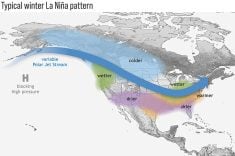It’s a scenario most farmers can only dream about.
The cost of their inputs goes up because of inflation, so a legislated formula kicks in to increase the price of the products they sell.
It might be fantasy for farmers, but it’s reality for railways for the 2005-06 crop year.
The Canadian Transportation Agency announced last week that the composite price index, or CPI, used in calculating the railways’ grain revenue cap for next crop year would increase by 4.4 percent.
That would work out to a rise of $1.23 per tonne on a single car rate of $28 a tonne, based on an average haul of 1,448 kilometres.
Read Also

Trump’s tariffs take their toll on U.S. producers
U.S. farmers say Trump’s tariffs have been devastating for growers in that country.
“The railways do not have to raise their rates, but if they do try to maximize their revenue, the single car rate could increase by that $1.23 a tonne,” said Jim Riegle, of the CTA rail costing division.
The prospect of paying more to ship grain is never welcome, say farmers, but is particularly galling this year given the railways’ recent performance hauling grain.
“When you look at their level of service it’s not justified,” said Les Felsch, a farmer from Ridgeville, Man., and transportation spokesperson for Keystone Agricultural Producers.
“We’re not getting our money’s worth.”
The 4.4 percent increase is made up of two factors. About two-thirds of it is a correction for an underestimation of railway costs, mainly fuel, in the current 2004-05 crop year.
The other one-third reflects projected cost increases, again mainly fuel, in 2005-06.
Railway officials say the increase in the CPI doesn’t automatically mean actual freight rates will rise by a corresponding amount.
“It’s one of the factors we look at but it’s only one, so it does not necessarily translate into a rate increase,” said Jim Feeny of Canadian National Railway.
The railway doesn’t want to leave money on the table, he said, but neither does it want to erode its competitive position.
Ed Greenberg of Canadian Pacific Railway said the railway is analyzing the CTA decision but hasn’t yet determined its rate structure for 2005-06.
“We’re still looking at the decision and how it fits into the competitive environment,” he said, adding it will be part of the mix in the company’s pricing strategy.
The CTA’s announcement came the same day as CPR announced net income of $81 million for the first quarter of 2005, up from $24 million in the same period last year. Revenue was up 14 percent to a record $1.01 billion.
Under the revenue cap system introduced in 2000, rail companies are free to set rates at any level, as long as their total grain-hauling revenues for the year do not exceed the cap.
However, grain industry officials say the experience of the past couple of years is that rates do in fact track changes in the cap, as the railways try to maximize their revenue.
“That has been their pattern,” said Canadian Wheat Board director Ian McCreary, who follows transportation issues for the board. “That’s what they attempt to do and they’re getting better at it.”
In 2003-04, CN’s grain revenues were $1.2 million below its $322 million cap, while CPR was $321,912 over its $310 million limit.
McCreary said the increase in the CPI for 2005-06 reinforces the need to bring in measures to force the railways to share productivity gains with shippers and farmers.
“It shows how imbalanced the legislation is. You get a few percentage points of productivity gains and we never see it. You get a few percentage points of inflation and the railways get to keep it all.”
Felsch agreed, saying the grain industry must continue to lobby the federal government to bring in more competitive provisions in the Canada Transportation Act.
Riegle said while shippers likely won’t be happy about the 4.4 percent increase, it would have been higher if not for the CTA’s decision to change the weighting of the six factors that go into determining the CPI Ñ labour, fuel, material, leased cars, depreciation and cost of capital.
The reweighting resulted in the CPI going up by 4.4 percent rather than 4.9 percent.
As a result, the combined revenue entitlement for the two railways in 2005-06 will be $701 million rather than $705 million, based on a volume of 26 million tonnes and an average haul of 1,448 km.
Shippers should also keep in mind that two-thirds of the increase reflects the fact that the 0.9 percent reduction in the 2004-05 CPI was based on a forecast that proved inaccurate.
“That suggests that shippers have been benefiting this year from a forecast for 2004-05 that appears to have been too low,” said Riegle.














